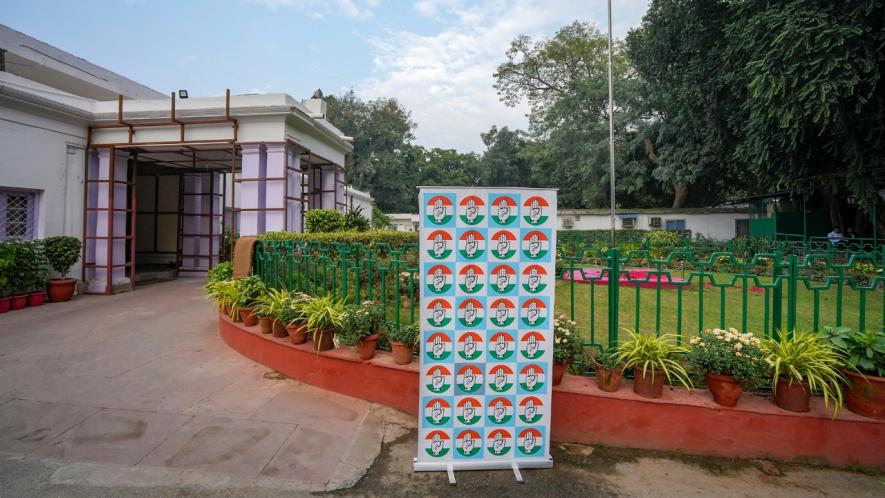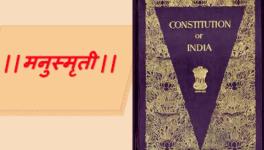Missed Opportunity for Congress Stuck in Dominant-party Mode

New Delhi: AICC headquarters on the day of the results of elections to the Legislative Assemblies of Telangana, Madhya Pradesh, Rajasthan and Chhattisgarh, on Sunday, Dec. 3, 2023. (PTI Photo/Manvender Vashist Lav)
The only consolation to be drawn from the Congress’s pounding at the hands of the Bharatiya Janata Party (BJP) in the just-concluded Assembly elections is that it can’t possibly pave the way for any further gains for the Sangh and its parivar in the Lok Sabha election in 2024. The BJP already has 61 of the 65 seats in Chhattisgarh, Madhya Pradesh and Rajasthan, with an ally holding one more. The Congress has a meagre three.
To understand how the promise divined in the run-up to the ‘semi-finals’ fizzled out so spectacularly one needs to probe both this reprise of Congress failures and the iteration of the BJP’s strengths. But before all that we need to look at the key electoral numbers beginning with 2014.
In 2014, when the BJP got a single-party majority after three decades of fractured mandates, it had swung 10 of 11 seats in its favour from Chhattisgarh, with 48.7 per cent of the vote; 27 of 29 in Madhya Pradesh, with 55 per cent; and all 25 in Rajasthan, with 55.6 per cent. In 2019, the numbers were, in the same sequence, nine and 50.7; 28 and 58; and, 24 and 58.5, with one seat going to an ally. The vote shares were humongous.
In 2014, the Congress got one seat in Chhattisgarh, with a vote share of 38.4 per cent; in Madhya Pradesh it got two seats, with a 35 per cent vote share; and, it drew a blank in Rajasthan, with 30.4 of the votes. In 2019, again in sequence, the numbers were, two and 41; one and 34.5; and, none and 34.2.
Nationwide, the BJP got 282 seats with 33 per cent the vote nationwide in 2014, while the Congress got 44 seats with 19.3 per cent. In 2019, the BJP got 303 seats, with 37.7 per cent of the vote and the Congress got 52 seats with 19.7 per cent. This was the story of the main opposition party’s calamitous collapse after 10 years in power.
But squashed between these, in the 2018 Assembly elections, the BJP got just 15 of 90 seats in Chhattisgarh, with 33 per cent of the vote, while the Congress got 68 seas with 43 per cent; in Madhya Pradesh, the BJP got 109 of 230 seats and 41 per cent, while the Congress got 114 seats, with 41 per cent; and, in Rajasthan, the BJP got 73 seats with 38.8 per cent, while the Congress won 100 seats of 200, with 39.3 per cent of the votes.
This, along with the optimism fanned by the Bharat Jodo Yatra (BJY) and the Congress’s comfortable win in Karnataka, was the basis for the hope that the party would stage a recovery in the run-up to 2024. It was dashed, with the BJP turning the tide in Chhattisgarh with 54 seats and a 46.3 per cent vote share; in Madhya Pradesh with 163 seats and 48. 6 per cent; and, in Rajasthan with 115 seats and 41.7 per cent. The Congress got 35 seats in Chhattisgarh, with 42.2 of the votes; in Madhya Pradesh 66 seats with 42.1 per cent votes; and in Rajasthan, 69 seats, with a 39.5 vote share.
The Congress’s vote share wasn’t significantly diminished—rising marginally in Madhya Pradesh and Rajasthan, and falling marginally in Chhattisgarh. In Rajasthan, the BJP and the Congress remained neck and neck, while the BJP made huge gains in the other two states.
The Congress can hardly console itself with the vote-share numbers, especially since its victory in Karnataka was caused by the congealing of the floating voters behind it. The BJP’s vote share remained practically the same. Soon after, the BJP, no stranger to hubris itself, tied up an alliance with the Janata Dal (S).
If the Congress fails to ramp up its vote share next year, remaining below 20 per cent to the BJP’s high 30s, it will fail to take enough seats to hurt the ruling party. Some of the regional parties could either increase their seat share to hurt the BJP (as, say, in Bihar, West Bengal and Jharkhand) or stay in place in oppositional roles (Tamil Nadu, Punjab). But if the Congress is steamrolled in the bipolar states, the BJP won’t really be bothered about marginal losses, though that doesn’t mean it will be complacent. Elections, rather than governance, are what it is all about, after all.
The question, then, is why the BJP succeeded in mobilising the floating vote behind it, while the Congress remained static despite the air of optimism swirling around it. One of the main reasons was that despite the high rhetoric on opposition unity and the formation of the Indian National Developmental Inclusive Alliance (INDIA), the Congress has not been able to shed its ingrained hauteur and develop a genuine coalition mentality, which it had to some extent when it stitched together the United Progressive Alliance twice. Which is odd, given that it was then in a far better position to call the shots. Now, languishing far behind the BJP, one would think that coalition-building would be a priority.
But in all three states, it eschewed alliances, while lecturing ‘smaller’ parties about ‘coalition dharma’. Deft coalitions could actually have helped it pull in some of the floating vote and made a difference, given that in Chhattisgarh and Rajasthan the gap was small. But 2023 became a story of lost opportunity, especially because the Congress took the paradoxical tack of playing up the caste census, while alienating precisely those parties that could help it mobilise the backward castes—the Rashtriya Janata Dal, the Janata Dal, (United) and the Samajwadi Party.
The Congress’s organisational disarray even after the presidential elections and the BJY is a serious problem. Mass outreach is important, but, as the BJP has shown time and again, organisational backbone is indispensable for last-mile delivery. You have to get people to vote for you on the day, which means putting in the hard work before the day dawns. The Congress seems to remain complacent about beefing up its organisation and, in this case, seemed to have taken its foot off the pedal when it came to the final campaign push. Infighting didn’t help, but the BJP also had factional issues in Madhya Pradesh and Rajasthan. It overcame them because it had boots on the ground, especially with Rashtriya Swayamsevak Sangh providing its cadres.
The Congress election pitch also became fatally ambiguous. In Karnataka, it stayed with the bread-and-butter issues. But, in this round, it attempted to sneak in a majoritarian message at the ground level, while the top leaders kept hammering home governance and welfare issues. It was never going to work. It should have the courage to stick to its principles and nous to realise it won’t be able to hijack the Hindutva pitch.
In a convoluted way, however, the Congress can rescue some positives from this electoral shellacking. First, it must repair bridges with allies, where appropriate, and build new ones, where they don’t exist. Second, it must urgently turn its attention to refurbishing or putting in place organisational structures.
And, finally, it should bid farewell to cynical leaders like Kamal Nath, who are both well past their sell-by dates and politically repugnant.
The author is an independent journalist and researcher. The views are personal.
Get the latest reports & analysis with people's perspective on Protests, movements & deep analytical videos, discussions of the current affairs in your Telegram app. Subscribe to NewsClick's Telegram channel & get Real-Time updates on stories, as they get published on our website.























